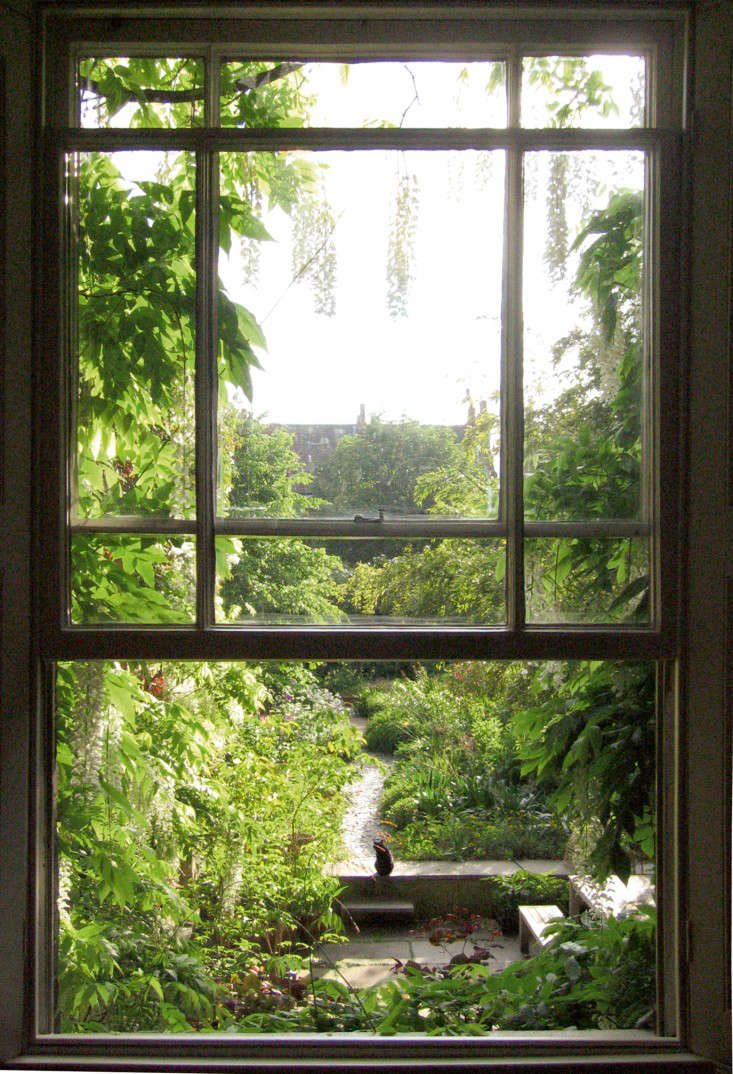When I first picked up Contemporary Designers’ Own Gardens I misjudged it, expecting the sort of book you might give to a gardener you don’t know very well. It appeared to be a glossy coffee table volume filled with lovely pictures and minimal text that doesn’t tell you much about anything, a book you browse but don’t really read. Fortunately, I was wrong.
If you like traveling to see gardens, especially secret gardens, this book is a delightful journey to the private landscapes created by 20 of today’s most innovative award-winning garden designers.

Above: Broughton Grange garden by Tom Stuart-Smith uses water to frame a tapestry of plants. Photograph by Andrew Lawson.
The book’s author Barbara Baker, a British writer described as a “keen” gardener, turns out to be an intrepid researcher, curious and tireless. Not only did she carefully choose the designers who appear in her book, she also traveled to 12 different countries to meet them and tour their gardens.

Above: Hornbeam shrubs delineate a lawn in a minimal landscape by Tom Stuart-Smith. Photograph by Barbara Baker.
All the people included here are professional garden designers and they all keep their private gardens closed to the public. Baker wanted to see firsthand what these people create when they are designing purely for themselves, free of clients’ scrutiny.

Above: Landscape at the entrance to the front of the home of landscape designer Jacques Wirtz. Photograph by Robin Baker.
While the gardens shown here are distinctive and very different from each other, there are certain patterns. As Baker points out, unlike their clients, most landscape designers are not wealthy people. Their resources for creating their personal gardens are usually much more limited than those of their clients and the actual size of the space tends to be much smaller. Some garden designers do hire gardeners to help, but they all seem to thrive on doing hands-on planting and maintenance work in their own spaces.
Baker’s research enables her to give us illuminating, well-observed biographical sketches of each person along with insights into each designer’s landscaping styles. The first designer in the book, Patrick Blanc, a colorful Parisian known for his vertical gardens, is shown in his house, which in effect is his private garden because wherever you go in it, you will see a wall covered with plants.

Above: Patrick Blanc at his desk with one of his vertical gardens in the background. Photograph by Barbara Baker.
We learn that he developed his vertical planting technique as a teenager living in his parents’ apartment. Baker was apparently allowed to roam at will in Blanc’s house. Many of the photos in this chapter are hers. We see Blanc at his desk, which sits on a sheet of glass that covers a room-sized fish pond built into the floor. We see the verdant outdoor shower and learn that Blanc uses it everyday, even in winter.

Above: The kitchen garden of Bunny Guinness with double cordon apple trees. Photograph by Robin Baker.
Another designer, Bunny Guinness, has a very distinctive but more conventional personal garden. Baker met with her in the UK near Peterborough in Cambridgeshire, where she has transformed the grounds of a former hardscrabble rental farm into eight distinct areas.

Above: Bunny Guinness’s new orchard with boxwood doughnuts placed at the base of the fruit trees. Photograph by Robin Baker.
There are formal gardens, a children’s play area with two treehouses, a walled garden with a lily pond, and a kitchen garden which produces fruit and vegetables for Guinness and her family. Like other designers in the book, Guinness says she often experiments here with plants she later uses professionally. She says, “I don’t feel I know a plant until I’ve grown it.”

Above: A Cercis canadensis in a pot at the entrance of Dan Pearson’s garden. Photograph by Huw Morgan.
Dan Pearson, a designer who was living in a Victorian row house in the Peckham area of London when Baker visited him, found the prospect of designing a garden just for himself very difficult. Without the restrictions of clients’ preferences, he found himself immobilized by too many choices. He ended up observing his backyard for an entire year before he broke ground.
The result is a tranquil oasis with a more colorful palette than Pearson normally uses for clients and where he allows favorite plants to self-seed, an indulgence he would never permit in one of his professional landscapes.

Above: View of Dan Pearson’s backyard garden. Photograph by Huw Morgan.

Above: Cloud pruned hedges in winter in Jacques Wirtz’s garden. Photograph courtesy of Wirtz International.
We also recently visited the Wirtz family’s garden. See our previous post Secret Garden: The Wirtz Family at Home in Belguim.

Above: A private client’s garden by Jacques Wirtz in Antwerp. Photograph courtesy of Wirtz International.
Baker says many of the designers she interviewed were notably more experimental with plant selection and more relaxed about maintenance in their private spaces. The result is that these personal gardens truly reflect the personalities and philosophies of their creators, giving them a powerful impact. As Baker writes, “Their gardens settled into my imagination and inspired me in my own garden, as I hope they will you too.”
Above: Contemporary Designers’ Own Gardens is available for $43.60 from Amazon.
Did you miss our recent review of Louis Benech: Twelve Gardens? (We adore his work too.)










Have a Question or Comment About This Post?
Join the conversation